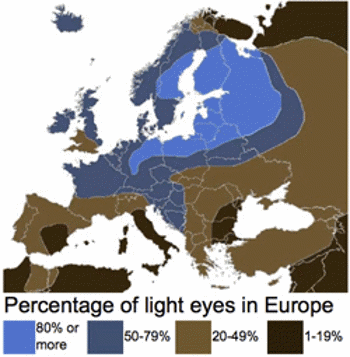
What is gene flow, genetic drift, and natural selection?
May 23, 2011

- Related Topics:
- Population genetics,
- Evolution
An undergraduate from California asks:
"Please help me to understand how gene flow, natural selection, and genetic drift affect gene frequencies; in the simplest form. I am in a physical anthropology class and am having a difficult time understanding this concept. Thank you."
Scientists can make things so hard with their jargon. These really are simple ideas wrapped in complicated terms.
Now it isn't the scientists' fault. They need this kind of shorthand to talk to each other about these ideas. Otherwise they'd take forever to discuss anything even remotely complicated.
But these terms do take some explaining for the rest of us. I think the easiest way to understand them is to use an example. As I like to do, I'll focus on eye color.
Imagine a group of blue-eyed Swedes up and moves to a small village in Rwanda. The Rwandans all have brown eyes and almost no one even has blue eyes hidden in their genes.
This sudden influx of genes that lead to blue eyes being present in the village is gene flow. The blue eye version (or allele) of an eye color gene has flowed into the population.
Before the population had 100% brown versions. Now it is close to 50%. The gene frequency of the blue allele has increased in this population because of gene flow.
Now imagine that all the Swedes live in the north part of the village. A freak storm comes and kills all of them.
The village has now returned to having mostly brown versions of the eye color gene. This is genetic drift - the percentage of blue eye alleles has decreased in the population because of a random event.
Finally, let's say that for some reason blue eyes are a real disadvantage in Africa. Maybe these folks are blinded by the sun and so tend to get eaten by lions. Or their associated fair skin leads to lots of birth defects and skin cancer because sunscreen and/or vitamin B supplements haven't been invented yet.
Whatever the reason, the Swedes have fewer kids in general than do the native Rwandans. Over time, there will be an increase in the number of brown eye alleles in the population because everyone with blue alleles dies out or at least doesn't do as well.
We are back to having more brown eye alleles in the population. The frequency of brown eye alleles has increased in the population because of natural selection.

And that's all there is to these concepts. Easy peasy when put into simple English.
The percentage of certain versions of genes can change because new versions move in, certain versions are lost or gained by accident, or certain genes do better in a certain environment. These definitely make sense. And there are plenty of examples of each out there in the world. Even among humans.
See below for some links to actual human examples of natural selection and genetic drift (gene flow is pretty self-explanatory). Who said genetics had to be hard!

Author: Dr. D. Barry Starr
Barry served as The Tech Geneticist from 2002-2018. He founded Ask-a-Geneticist, answered thousands of questions submitted by people from all around the world, and oversaw and edited all articles published during his tenure. AAG is part of the Stanford at The Tech program, which brings Stanford scientists to The Tech to answer questions for this site, as well as to run science activities with visitors at The Tech Interactive in downtown San Jose.
 Skip Navigation
Skip Navigation
